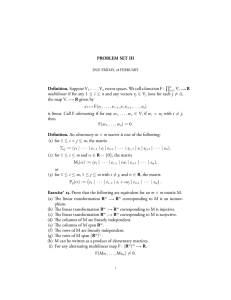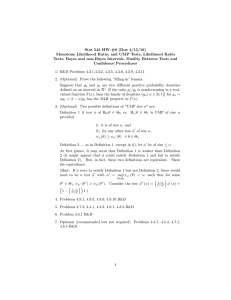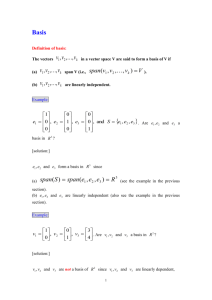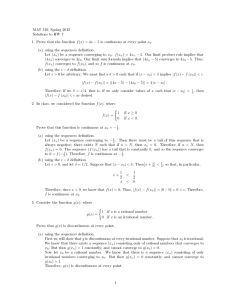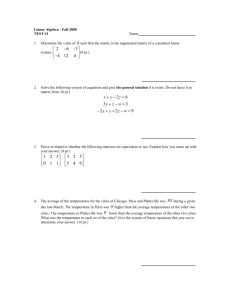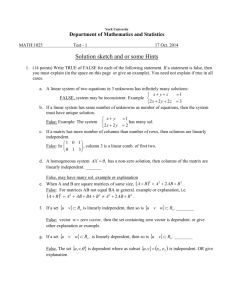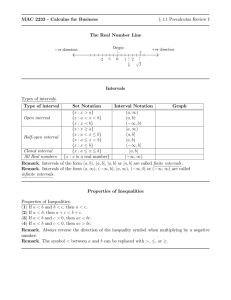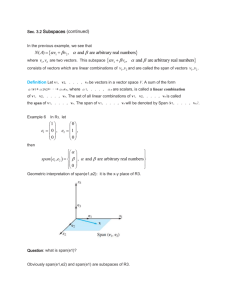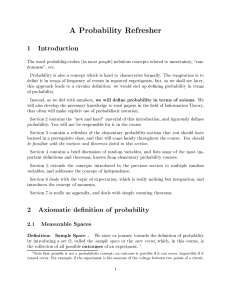http://people.cs.uchicago.edu/ laci/reu04.
advertisement
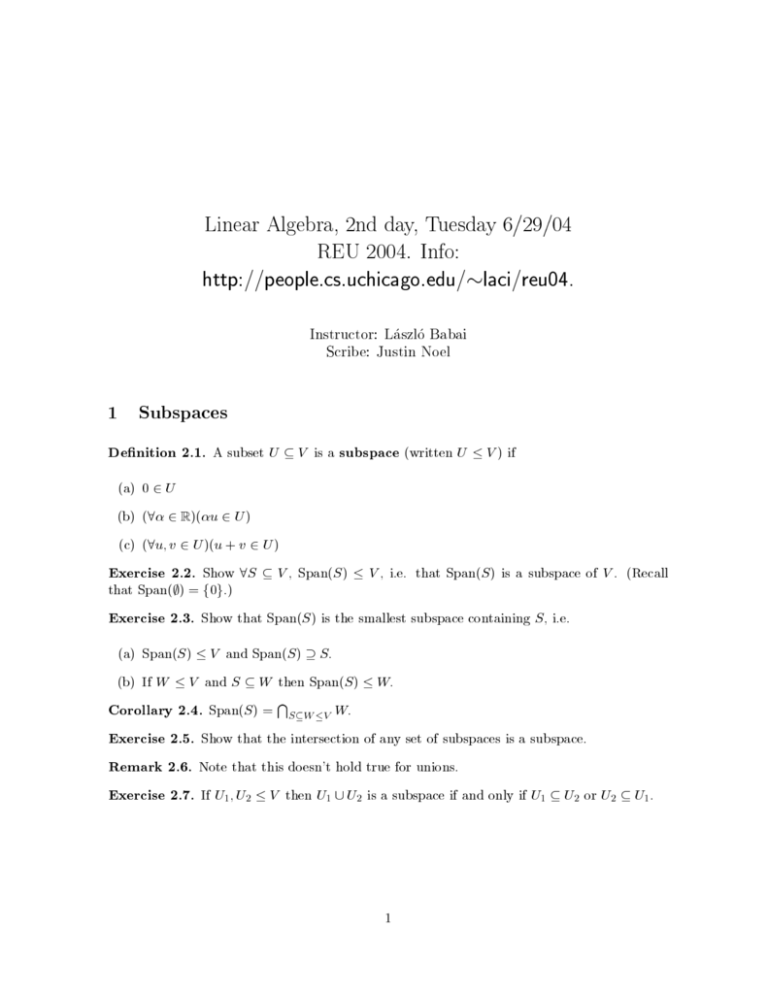
Linear Algebra, 2nd day, Tuesday 6/29/04 REU 2004. Info: http://people.cs.uchicago.edu/ laci/reu04. Instructor: Laszl o Babai Scribe: Justin Noel 1 Subspaces Denition 2.1. A subset U V is a subspace (written U V ) if (a) 0 2 U (b) (8 2 R)(u 2 U ) (c) (8u; v 2 U )(u + v 2 U ) Exercise 2.2. Show 8S that Span(;) = f0g.) V , Span(S ) V , i.e. that Span(S ) is a subspace of V . (Recall Exercise 2.3. Show that Span(S ) is the smallest subspace containing S , i.e. (a) Span(S ) V and Span(S ) S: (b) If W V and S W Corollary 2.4. Span(S ) = then Span(S ) W: T S W V W: Exercise 2.5. Show that the intersection of any set of subspaces is a subspace. Remark 2.6. Note that this doesn't hold true for unions. Exercise 2.7. If U1 ; U2 V then U1 [ U2 is a subspace if and only if U1 U2 or U2 U1 . 1 2 All bases are equal Theorem 2.8 (Fundamental Fact of Linear Algebra). If L; M V with L is a linearly independent set of vectors, and L Span(M ) then jLj jM j. Lemma 2.9 (Steinitz Exchange Principle). If v1 ; : : : ; vk are linearly independent and v1 ; : : : ; vk 2 Span(w1 ; : : : ; w` ) then 9j; 1 j ` such that wj ; v2 ; : : : ; vk are linearly independent. (Note in particular that wj 6= v2 ; : : : ; vk .) Exercise 2.10. Prove the Steinintz Exchange Principle. Exercise 2.11. Prove the Fundamental Fact using the Steinitz Echange Principle. Denition 2.12. An m n matrix is an m n array of numbers fij g which we write as 0 B@ 11 1n m1 mn .. . ... .. . 1 CA Denition 2.13. The row (respectively column) rank of a matrix is the rank of the set of row (respectively column) vectors. Theorem 2.14 (The Most Amazing Fact of Basic Linear Algebra). The row rank of a matrix is equal to its column rank. (To be proven later in today.) Denition 2.15. Let S V , then a subset B S is a basis of S if (a) B is linearly independent. (b) S Span(B ). Exercise 2.16. Show that the statement: \All bases for S have equal size" is equivalent to Theorem ??. Denition 2.17. We call the common size of all bases of S the rank of S , denoted rk(S ). 3 Coordinates Exercise 2.18. Show that B S is a basis if and only if B is a maximal linearly independent subset of S . Exercise 2.19. If B is a basis of S then 8x 2 S there exists a unique linear combination of elements in B that sums to x. In other words for all x there are unique scalars i such that x= k X i=1 2 i bi : Denition 2.20. For a basis B , regarded as an ordered set of vectors, we associate to each x 2 S the column vector 0 1 1 B . [x]B := @ .. C A k called the coordinates of x, where the i are as above. 4 Linear maps, isomorphism of vector spaces Denition 2.21. Let V and W be vector spaces. We say that a map f : V homomorphism or a linear map if !W is a (a) (8x; y 2 V )(f (x + y ) = f (x) + f (y )) (b) (8x 2 V )(8 2 R)(f (x) = f (x)) Exercise 2.22. Show that if f is a linear map then f (0) = 0. P P Exercise 2.23. Show that f ( ki=1 i vi ) = ki=1 i f (vi ). Denition 2.24. We say that f is an isomorphism if f is a bijective homomorphism. Denition 2.25. Two spaces V and W are isomorphic if there exists an isomorphism between them. Exercise 2.26. Show the relation of being isomorphic is an equivalence relation. Exercise 2.27. Show that an isomorphism maps bases to bases. Theorem 2.28. If dim(V ) = n then V = Rn . Proof: Choose a basis, B of V , now map each vector to its coordinate vector, i.e. v 7! [v]B . Denition 2.29. We denote the image of f as the set im(f ) = ff (x) : x 2 V g Denition 2.30. We denote the kernel of f as the set ker(f ) = fx 2 V : f (x) = 0g Exercise 2.31. For a linear map f : V ! W show that im(f ) W and ker(f ) V . Theorem 2.32. For a linear map f : V ! W we have dim ker(f ) + dim im(f ) = dim V: Lemma 2.33. If U V and A is a basis of U then A can be extended to a basis of V . Exercise 2.34. Prove Theorem ??. Hint: apply Lemma ?? setting U = ker(f ). 3 5 Vector spaces over number elds Denition 2.35. A subset F C is a number eld if F is closed under the four arithmetic operations, i.e. for ; 2 F (a) 2 F (b) 2 F (c) 2 F (assuming 6= 0). Exercise 2.36. Show that if F is a number eld then Q F. p p3 Exercise 2.37. Show that Q[ 2] is a number eld. p p Exercise 2.38. Show that Q[ 2] = fa + b 3 2 + c 3 4 : a; b; c 2 Qg is a number eld. Exercise 2.39 (Vector Spaces over Number Fields). Convince yourself that all of the things we have said about vector spaces remain valid if we replace R and F. Exercise 2.40. Show that if F; G are number elds and F G then G is a vector space over F. Exercise 2.41. Show that dimR C = 2. Exercise 2.42. Show that dimQ R has the cardinality of \continuum," that is, it has the same cardinality as R. Exercise 2.43 (Cauchy's Equation). We consider functions f : R ! R satisfying Cauchy's Equation: f (x + y ) = f (x) + f (y ) with x; y 2 R: For such a function prove that (a) If f is continuous then f (x) = cx. (b) If f is continuous at a point then f (x) = cx. (c) If f is bounded on some interval then f (x) = cx. (d) If f is measurable in some interval then f (x) = cx. (e) There exists a g : R ! R such that g (x) 6= cx but g (x + y ) = g (x) + g (y ). (Hint: Use the fact that R is a vector space over Q. Use a basis of this vector space. Such a basis is called a Hamel basis. p p p p p p p p Exercise 2.44. Show that 1; 2; and 3 are linearly independent over Q. p Exercise 2.45. Show that 1; 2; 3; 5; 6; 10; 15 and 30 are linearly independent over Q. 4 Exercise 2.46. Show that the set of square roots of all of the square-free integers are linearly independent over Q. (An integer is square free if it is not divisible by the square of any prime number. For instance, 30 is square free but 18 is not.) Denition 2.47. A rational function f over R is a fraction of the form g(x) f (x) = h(x) where g; h 2 R[x] (that is g; h are real polynomials) and h(x) 6= 0 (h is not the identically zero polynomial). More precisely, a rational function is an equivalence class of fractions of g (x) g (x) polynomials, where the fractions 1 and 2 are equivalent if and only if g1 h2 = g2 h1 : h1 (x) h2 (x) (This is analogous to the way fractions of integers represent rational numbers; the fractions 3/2 and 6/4 represent the same rational number.) We denote the set of all rational functions as R(x). Note that a rational function is not a function; it is an equivalence class of formal quotients. Exercise 2.48. Prove that the rational functions f x 1 : 2 Rg are linearly independent set over R(x). Corollary 2.49. dimR[x] R(x) has the cardinality of \conyinuum" (the same cardinality as R). 6 Elementary operations Denition 2.50. The following actions on a set of vectors fv1 ; : : : ; vk g are called elementary operations: vj where i 6= j . (b) Replace vi by vi where 6= 0. (c) Switch vi and vj . Exercise 2.51. Show that the rank of a list of vectors doesn't change under elementary (a) Replace vi by vi operations. Exercise 2.52. Let fv1 ; : : : ; vk g have rank r. Show that by a sequence of elementary operations we can get from fv1 ; : : : ; vk g to a set fw1 ; : : : ; wk g such that w1 ; : : : ; wr are linearly independent and wr+1 = = wk = 0. Consider a matrix. An elementary row-operation is an elementary operation applied to the rows of the matrix. Elementary column operations are dened analogously. Exercise ?? shows that elementary row-operations do not change the row-rank of A. Exercise 2.53. Show that elementary row-operations do not change the column-rank of a matrix. Exercise 2.54. Use Exercises ?? and ?? prove the \amazing" Theorem ??. 5
